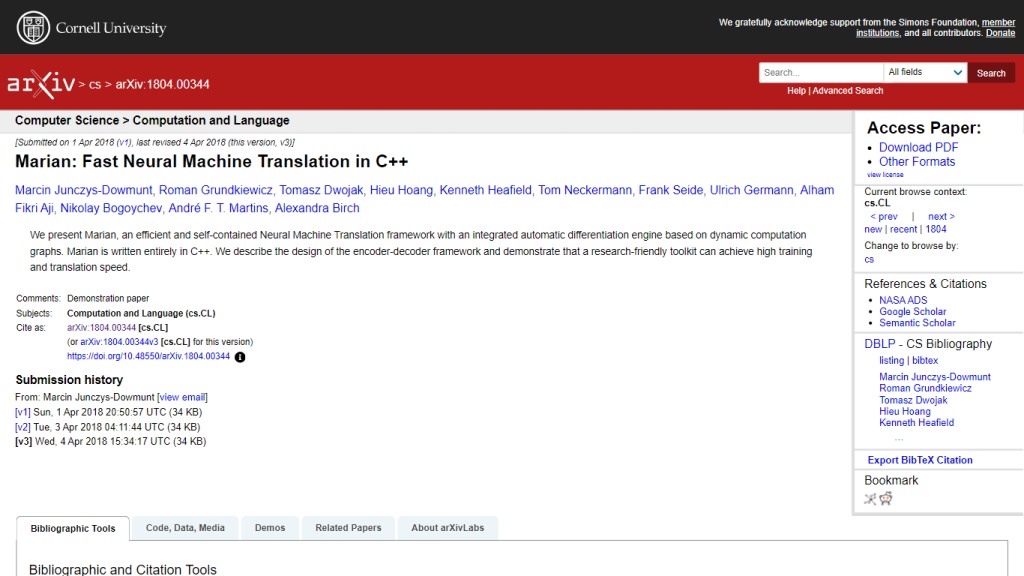What is Marian?
Marian is the newest state-of-the-art Neural Machine Translation framework, developed with both speed and efficiency in mind, targeting both research and production environments. It is a highly specialized framework, written in its entirety in C++, having an architecture that includes a self-contained automatic differentiation engine. Some of the peculiarities of Marian are the use of dynamic computation graphs. This can enable fast model experimentation and iteration. It is at home handling a large variety of NMT models—in particular, it supports the very popular encoder-decoder framework, so becoming one of the favorite tools among computational linguistics researchers.
Marian’s Key Features & Benefits
High Performance: Fast training and translation speed ensure computational efficiency.
Self-Contained: It has an inbuilt automatic differentiation engine, an aspect that makes the architecture simple and easy to use.
Dynamic Computation Graphs: This supports flexibility and fast iteration over designs of models.
C++ Implementation: Development in C++ ensures that Marian works efficiently and has high performance.
Research-Friendly: Since Marian is developed for use by researchers, it is pretty easy to use academically with ease for experimental purposes in computational linguistics.
Use Cases and Applications of Marian
Marian can be used in many cases where machine translation happens to be the core requirement. The major areas of its application include:
- Academic Research: It can be utilized by researchers in the domain of computational linguistics to develop and then test the newer models of translation.
- Production Environments: Any organization in need of quality and quicker translation services can easily integrate Marian into their systems.
- Language Translation Services: Any agency involved in offering translation services can use Marian to enhance the accuracy and speed in its translations.
How to Use Marian
There are a number of steps to using Marian, from installation to the running of the translation models:
- Installation: Download and install Marian from the official repository.
- Setting Up the Model: An NMT model of choice can be used, like the encoder-decoder framework.
- Training: Train the model on an appropriate dataset to get the desired translation capacity.
- Translation: Finally, using the trained model, translate text from one language to another. Also, the best practices are also updating the framework and models regularly to include all the new developments and optimizations. Knowledge of C++ is useful to go through and modify most of the features in Marian.
How Marian Works
Marian has a solid technical base; it has a self-contained architecture with dynamic computation graphs. Core technology includes:
- Automatic Differentiation Engine: computation of gradients necessary for model training.
- Dynamic Computation Graphs: Allow for flexible and efficient model iterations.
- Encoder-Decoder Framework: One of the prime architectures in NMT that enables the translation of sequences from one language to another.
That means setting up the model, training it on some dataset, and eventually using a trained model for translation tasks. In Marian’s design, it’s ensured that these whole procedures are fast and efficient.
Marian Pros and Cons
Like any technology, Marian has its pros and cons:
Pros:
- High training and translation speeds
- Self-contained architecture makes it easy to use
- Dynamic computation graphs make it flexible
- Efficient C++ implementation
- Easy to be used by researchers for experiments
Cons:
- Requires a good knowledge of C++ for the best utilization.
- Not very user-friendly to beginners compared to other NMT frameworks.
Conclusion on Marian
One of the high-performance, efficient, research-friendly NMT frameworks is Marian. The excellent C++ implementation and dynamic computation graphs recommend it for further research and production environments. This would be known to require some technical knowledge in bringing out all its potential; its gain in terms of speed and flexibility is really very nice. Looking forward, it is expected to have continued updates and developments that strengthen Marian’s capabilities.
Marian FAQs
What is Marian?
Marian is a framework for Neural Machine Translation that is fast, efficient, and self-contained with an integrated automatic differentiation engine based on dynamic computation graphs.
In which programming language is Marian written?
Marian is written in C++ only; thus, it is highly performance- and efficiency-oriented.
Does Marian have some specific architecture of neural machine translation?
Marian contains an encoder-decoder framework that forms the core architecture for many NMT systems.
When was the paper on Marian submitted and last revised?
The paper describing Marian was submitted to arXiv on 1 April 2018, with the last revision date being 4 April 2018.
Is Marian suitable for research and academic use?
Marian is designed to enable research and experiments to be carried out, so it is practical in its usage as a toolkit for researchers in computational linguistics.










